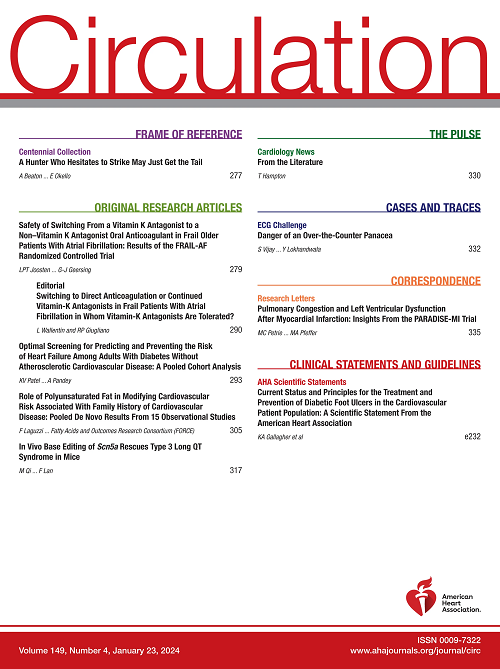由主动脉三维几何形状决定的早期血管老化:遗传决定因素和临床后果。
IF 35.5
1区 医学
Q1 CARDIAC & CARDIOVASCULAR SYSTEMS
引用次数: 0
摘要
背景血管老化是一种以结构和几何重塑为特征的重要表型。一些个体表现出异常的血管老化,与心血管预后改善有关;其他人则经历早期血管衰老,这与心血管疾病的不良后果有关。主动脉是表现出最明显的年龄相关变化的动脉;然而,主动脉老化的生物学机制、遗传结构及其与心血管结构、功能和疾病状态的关系仍然知之甚少。方法:基于英国生物银行(UK Biobank)和宾夕法尼亚大学医学生物银行(Penn Medicine Biobank)这两个大型生物银行的三维断层成像数据得出的主动脉几何表型,我们开发了性别特异性模型来量化主动脉年龄。卷积神经网络辅助的主动脉三维分割在英国生物银行的56104个磁共振成像扫描和宾夕法尼亚医学生物银行的6757个计算机断层扫描中进行。主动脉血管年龄指数(AVAI)计算为几何表型预测的血管年龄与实足年龄之间的差异,以实足年龄的百分比表示。我们使用多元线性回归评估了与心血管结构和功能的关联,并通过全基因组关联研究检查了AVAI的遗传结构,随后采用孟德尔随机化来评估因果关系。我们还构建了AVAI的多基因风险评分。结果savai与心脏结构和功能有多种关联,包括左心室质量增加(标准化β=0.144 [95% CI, 0.138, 0.149];P<0.0001),壁厚(标准化β=0.061 [95% CI, 0.054, 0.068];P<0.0001),最大左心房容积(标准化β=0.060 [95% CI, 0.050, 0.069];P < 0.0001)。AVAI具有较高的遗传力(h2=40.24%)。我们鉴定出54个与AVAI相关的独立遗传位点(P<5×10-8),它们进一步显示出与纤维蛋白-1 (FBN1)和弹性蛋白(ELN1)基因的基因水平关联。孟德尔随机化支持AVAI与房颤、血管性痴呆、主动脉瘤和主动脉夹层之间的因果关系。AVAI的多基因风险评分与房颤、高血压、主动脉瘤和主动脉夹层患病率增加相关。结论主动脉早期老化与心脏重构不良及重要心血管疾病状态相关。AVAI具有多基因、高度可遗传的遗传结构。孟德尔随机化分析支持AVAI与心血管疾病之间的因果关系,包括心房颤动、血管性痴呆、主动脉瘤和主动脉夹层。本文章由计算机程序翻译,如有差异,请以英文原文为准。
Early Vascular Aging Determined by 3-Dimensional Aortic Geometry: Genetic Determinants and Clinical Consequences.
BACKGROUND
Vascular aging is an important phenotype characterized by structural and geometric remodeling. Some individuals exhibit supernormal vascular aging, associated with improved cardiovascular outcomes; others experience early vascular aging, linked to adverse cardiovascular outcomes. The aorta is the artery that exhibits the most prominent age-related changes; however, the biological mechanisms underlying aortic aging, its genetic architecture, and its relationship with cardiovascular structure, function, and disease states remain poorly understood.
METHODS
We developed sex-specific models to quantify aortic age on the basis of aortic geometric phenotypes derived from 3-dimensional tomographic imaging data in 2 large biobanks: the UK Biobank and the Penn Medicine BioBank. Convolutional neural ne2rk-assisted 3-dimensional segmentation of the aorta was performed in 56 104 magnetic resonance imaging scans in the UK Biobank and 6757 computed tomography scans in the Penn Medicine BioBank. Aortic vascular age index (AVAI) was calculated as the difference between the vascular age predicted from geometric phenotypes and the chronological age, expressed as a percent of chronological age. We assessed associations with cardiovascular structure and function using multivariate linear regression and examined the genetic architecture of AVAI through genome-wide association studies, followed by Mendelian randomization to assess causal associations. We also constructed a polygenic risk score for AVAI.
RESULTS
AVAI displayed numerous associations with cardiac structure and function, including increased left ventricular mass (standardized β=0.144 [95% CI, 0.138, 0.149]; P<0.0001), wall thickness (standardized β=0.061 [95% CI, 0.054, 0.068]; P<0.0001), and left atrial volume maximum (standardized β=0.060 [95% CI, 0.050, 0.069]; P<0.0001). AVAI exhibited high genetic heritability (h2=40.24%). We identified 54 independent genetic loci (P<5×10-8) associated with AVAI, which further exhibited gene-level associations with the fibrillin-1 (FBN1) and elastin (ELN1) genes. Mendelian randomization supported causal associations between AVAI and atrial fibrillation, vascular dementia, aortic aneurysm, and aortic dissection. A polygenic risk score for AVAI was associated with an increased prevalence of atrial fibrillation, hypertension, aortic aneurysm, and aortic dissection.
CONCLUSIONS
Early aortic aging is significantly associated with adverse cardiac remodeling and important cardiovascular disease states. AVAI exhibits a polygenic, highly heritable genetic architecture. Mendelian randomization analyses support a causal association between AVAI and cardiovascular diseases, including atrial fibrillation, vascular dementia, aortic aneurysms, and aortic dissection.
求助全文
通过发布文献求助,成功后即可免费获取论文全文。
去求助
来源期刊

Circulation
医学-外周血管病
CiteScore
45.70
自引率
2.10%
发文量
1473
审稿时长
2 months
期刊介绍:
Circulation is a platform that publishes a diverse range of content related to cardiovascular health and disease. This includes original research manuscripts, review articles, and other contributions spanning observational studies, clinical trials, epidemiology, health services, outcomes studies, and advancements in basic and translational research. The journal serves as a vital resource for professionals and researchers in the field of cardiovascular health, providing a comprehensive platform for disseminating knowledge and fostering advancements in the understanding and management of cardiovascular issues.
 求助内容:
求助内容: 应助结果提醒方式:
应助结果提醒方式:


